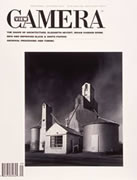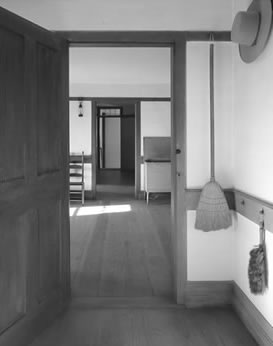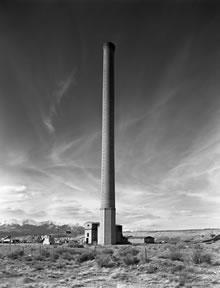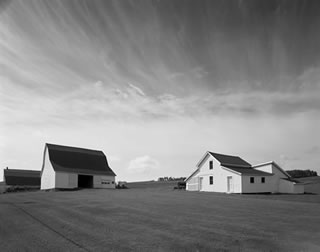 |
Rural Architecture
By Steve Simmons
Reprinted by permission from the Sept/Oct 2000 issue of View Camera magazine. Copyright 1994 by View Camera. All rights reserved.
A few days after I completed an interview with Brian Vanden
Brink he called me and said, "I have just come across an interview with
someone who said of Walker Evans, 'Walker gave dignity to everything he
photographed'. I like that, and hope that in some small way, the same will
be true of my work when all is said and done."
Vanden Brink has been photographing rural architecture sine his early
days growing up in Nebraska. "Most of my photos were of buildings-rural
buildings," he explains. "This is what I feel strongest about."
It is an avocation and passion that Vanden Brink has turned into a
career. While growing up he traveled across much of Western Nebraska and
developed a real love for the feeling and mood of the wild prairie. "I love
this work. I enjoy finding dignity and beauty in the common buildings on
someone's farm," he states.
|

On the Cover:
Grain Elevators,
Long Island, Kansas
©Brian Vanden Brink
|
In 1979, Vanden Brink and his wife left Nebraska and moved to the East
Coast, eventually settling in Maine.
While Maine may seem like a long way from Nebraska, according to Vanden
Brink, "Certain parts of Maine are like Nebraska. Northern Maine has the
huge rolling hills that I had seen growing up in the Midwest."
The move to Maine was one that was initially unplanned, as Vanden Brink
explains. "Actually, Maine was a bit of an accident because we first settled
in Western Massachusetts. We were then in Boston for a short while. Later I
learned about the Maine Photographic Workshops and came here to take their
three month basic program in photography. We just stayed. There is a
peacefulness here-a slower pace and a sense of separation from the noise and
hurry of the city."

Shaker Interior,
Sabbath Day Lake, Maine
|
The program at the Maine Photographic Workshops is the only formal
training Vanden Brink has ever had in photography. Otherwise he is
completely self-taught.
"My original goal," he states, "was to do fine art photography. I could
see that wasn't going to work for me though. We were going to have a child
and I needed to earn a living."
Architectural photography in general, and certainly in a rural part of
the country such as Maine, can be an up and down living. Vanden Brink has
managed to successfully even out the peaks and valleys.
"I can't depend on just Maine," he states. "The magazines are an
important part of my income as well." Vanden Brink has cultivated
relationships with most of the professional architectural publications such
as Architecture, Progressive Architecture, the building trade publications,
many of the interior design magazines such as Architectural Digest, Down
East (a local publication with a national reputation), and with other
publications such as Country Living. He is frequently hired directly b y one
of their art directors. When he is hired by the architect or interior
designer he looks for stock sales as well.
|
"My relationship with Down East is great," Vanden Brink states. "They
frequently allow me to create my own assignments which helps me build my
stock files and explore Maine as well."
During the interview I asked Vanden Brink if there was a difference in
shooting an assignment directly for an architect as opposed to an art
director for a magazine. "It is just as much fun for me to shoot for an
architect as it is for a magazine," he responds. "The only difference is
that there is more of a market for the photographs that are done for an
architect."
It is all personal work for him. "I would choose this [photographing
rural architecture] over almost anything else. It may seem accidental, but
I'm always looking [for images] as I travel around the countryside," Vanden
Brink explains.
Architectural photographers are almost always working with as much or
more contrast than their film can handle. The majority of daylight color
transparency films can handle four to four and a half stops of contrast. A
typical color negative film can generally handle only about four stops of
contrast by comparison. Consequently, the photographer has to add
supplemental lighting, or judiciously select the best times of the day to
photograph the different areas of the building.
Vanden Brink's solution to this particular problem is to use Ektachrome
64T film which has a longer tonal range-perhaps as much as five to five and
a half stops.
"It is very forgiving film, and it is very predictable as well. I am
amazed at the contrast range it can handle." states Vanden Brink.
To correct this tungsten film for daylight Vanden Brink uses either an
85B or 85C Light Balancing (LB) filter. In an interior situation he may
shoot without the filter, or pick one of the weaker filters such as the 81
series to split the difference between the daylight and the tungsten
depending upon the amount of color of the available daylight and the desired
mood.
|

Abandoned Smelter Stack,
Salida, Colorado
|
His style of interior lighting is quite minimal.
"When I was just starting out I could not afford expensive equipment so
I went to the local hardware store and bought the lights I saw displayed
there. For awhile I felt crippled by not having larger strobe units," he
recalls.
In looking back, however, Vanden Brink is pleased that necessity forced
some creative solutions.
"I am glad I did not have the money for the larger and more powerful
lights. By necessity I had to find ways to work around the limits of my
equipment," he explains. "The key for me is not to light too much. Sometimes
I do not use lights at all."
His preference is to use the sun as his primary light source, using just
enough fill light to open up the shadows. "I like to work around the sun. My
clients like this feeling as well."
His look is now part of what sells his services to old and new clients
alike. "After awhile people are hiring you because they like the way you
see, the way you experience a building," Vanden Brink states.

Farm Buildings,
Aroostook County, Maine
|
"I feel comfortable with the style I've developed. It looks very
natural. It is natural, it's the sun."
Indeed, that is the difficult task of the architectural and interior
photographer; e.g. to go through all of the work to make the image look
natural; as if nothing needed to be done to make the scene photographable.
"We can get so sophisticated with equipment," Vanden Brink says, "but it
doesn't lead to better photography. Atget had very crude equipment but his
images are wonderful."
Although the bulk of Vanden Brink's assignment work is color
photography, he will also expose black and white film of the job at the same
time. "I use black and white film on every job as well" explains Vanden
Brink. "If the image is strong, the potential is there for both media."
|
Contrary to some photographers who have experienced difficulties when
working with both black and white and color film at the same time, Vanden
Brink does feel not there is a problem working with both materials
simultaneously. "I have never found it difficult to use both types of film
at the same time," he states. "I just put another holder into the camera
with the other film."
Vanden Brink has his own approach to shooting black and white on the
job. He gives his black and white film, usually Tri-X, the same exposure as
his color material. Vanden Brink then has a lab process the film for less
than normal time. This gives him a very flat, but printable negative.
"I overexpose everything by a stop or two and then all the film is
processed the same," he explains. "I can then use variable contrast paper to
make the prints."
"When I am busy shooting in the Summer I just do not have time to
process my own film. During the long Maine winters, however, I love to print
my black and white negatives. This is when I update my portfolio. I would
love to have a show of my black and white work someday."
If his architectural photography business continues to be as strong as
it has been in 1994, Vanden Brink will have a lot of updating to do this
winter. "I have been particularly busy this year," Vanden Brink states. "It
is nice because we don't have very many boom times."
Vanden Brink is still enthralled with Maine. "I am still exploring,
almost everyday," he states. "There is such a variety of architectural
styles here to work with and photograph."
It is the dream of many people, not just photographers, to find an
avocation that earns us a living. Vanden Brink has managed to do just that.
"Part of my pay is my work that I love to do. I feel like I have the best
job in the world."
|
 |



